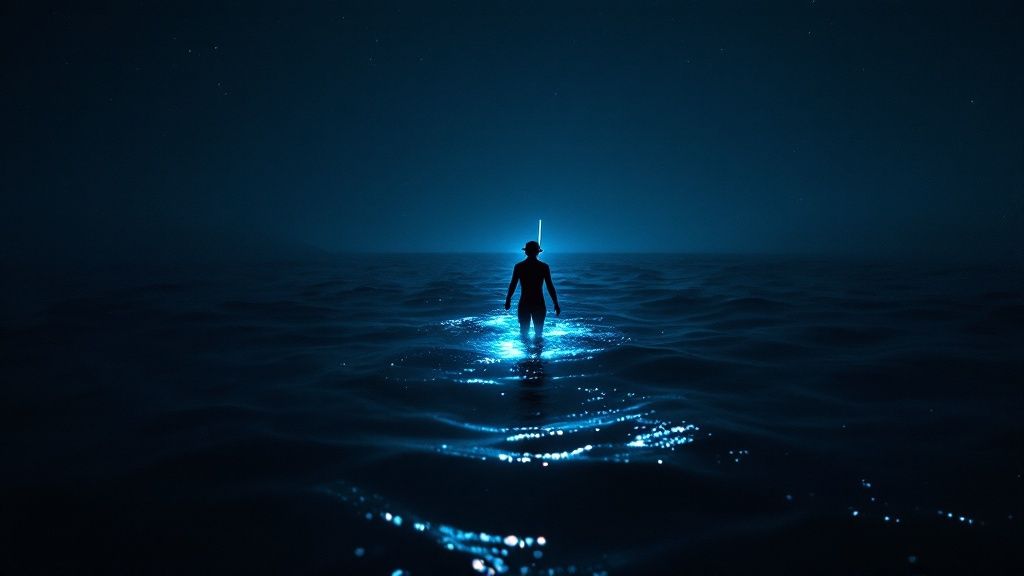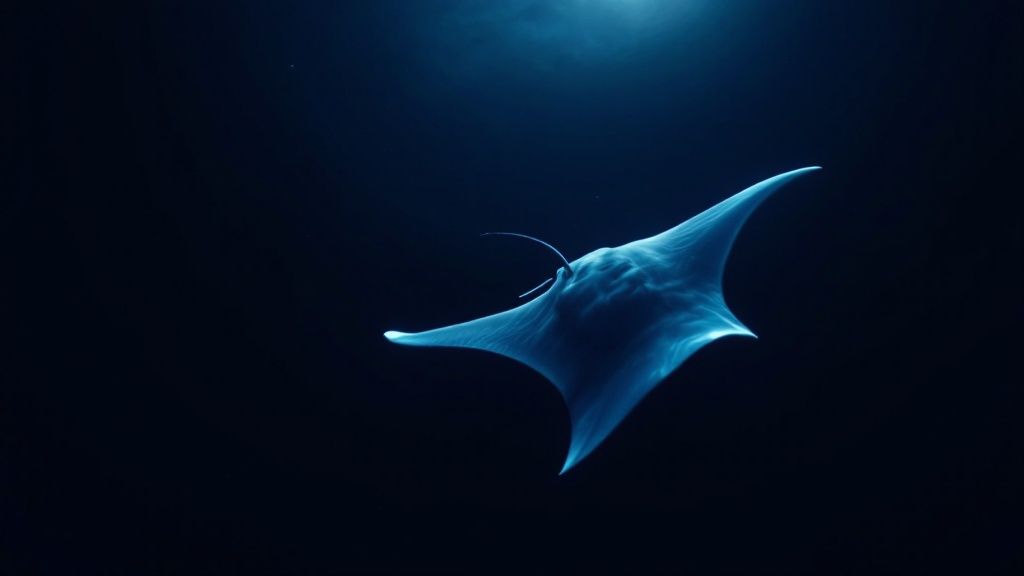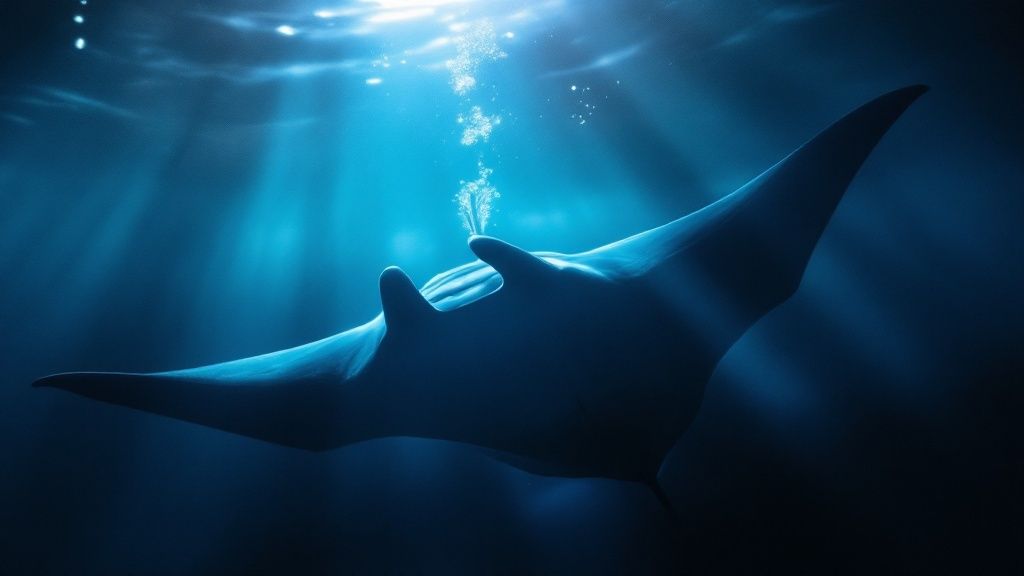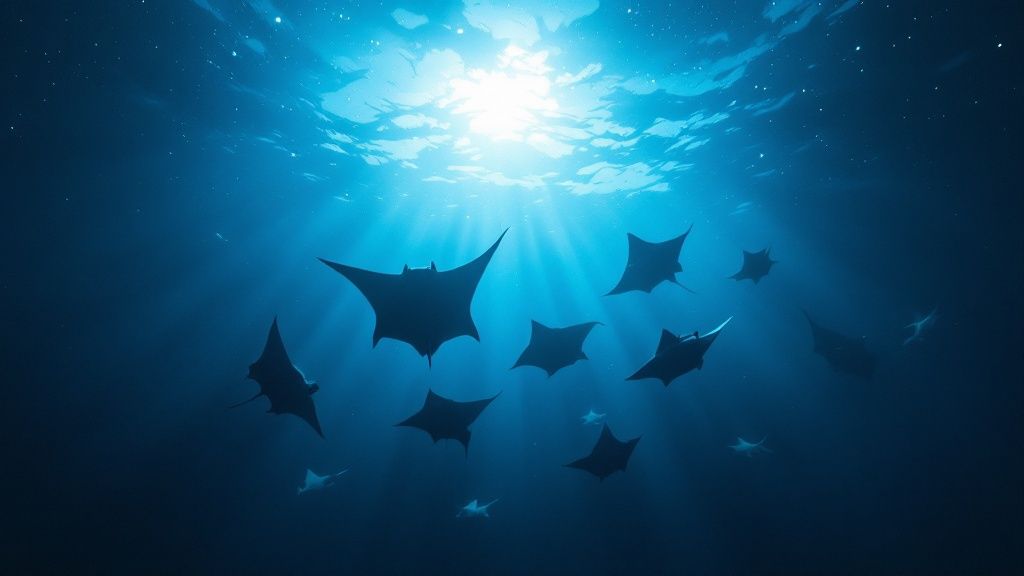Night snorkel with manta rays: Hawaii Thrills
- Byron
- Mar 18
- 11 min read
The Magic of Night Snorkel With Manta Rays

Imagine floating in the dark ocean, the only light coming from gentle underwater beams. Then, a magnificent manta ray appears, its ten-foot wingspan gliding effortlessly through the water. This is the magic of a night snorkel with manta rays. It's a unique experience, a window into a hidden world where these gentle giants perform their captivating underwater ballet.
The Allure of the Dark
Night transforms the ocean. While daytime snorkeling reveals vibrant coral and colorful fish, nighttime brings mystery. The darkness heightens your senses, creating an immersive experience. The gentle rocking of the ocean, the quiet sounds of marine life, and the anticipation of seeing these magnificent creatures make this an unforgettable adventure.
The Manta Ray's Dance
The magic of this encounter lies in the manta ray's feeding habits. Manta rays are filter feeders, eating huge amounts of tiny plankton. Like moths to a flame, plankton are drawn to light. Tour operators use this by shining lights into the water, creating a plankton feast that attracts the manta rays. Snorkelers then get an up-close view as the mantas perform graceful barrel rolls, filtering the plankton-rich water.
Manta Ray Night Snorkel Popularity
Since 2020, when new legislation restricted dolphin interactions, manta ray night snorkeling has become increasingly popular. It provides a responsible way to engage with marine life. The lights from flotation devices used on these tours attract both manta rays and their main food source, phytoplankton. The Big Island's clear, warm waters are ideal for this experience, letting you watch mantas perform their captivating barrel rolls right beneath you. Learn more about this rising popularity here.
A Spiritual Connection
For native Hawaiians, manta ray encounters are deeply spiritual. These creatures are often considered aumakua, or family guardians, symbolizing wisdom and grace. This cultural reverence adds another dimension to the experience, connecting visitors to the islands' rich history and traditions. This profound connection between nature and culture makes the night snorkel even more alluring. It’s not just about seeing an amazing natural phenomenon; it’s also about understanding the Hawaiian people’s deep respect for the ocean and all its inhabitants.
Prime Locations for Night Snorkel With Manta Rays

The Big Island's Kona Coast is a world-renowned destination for manta ray encounters. However, not all viewing locations are the same. Choosing the right spot can significantly enhance your chances of an unforgettable night snorkel.
Keauhou Bay: The Famous Manta Village
Keauhou Bay, affectionately nicknamed "Manta Village," is known for its resident manta ray population. This translates to remarkably consistent sightings and a high probability of close encounters. The bay's calm waters and shallow depths create an ideal environment for both novice and experienced snorkelers. The diverse bottom topography, featuring sandy patches and coral formations, provides perfect feeding grounds for these gentle giants.
Makako Bay: A Cove Teeming With Life
Makako Bay, also known as "Garden Eel Cove," offers a distinct experience. While also a popular manta ray night snorkel site, it tends to attract larger manta rays, sometimes even oceanic mantas. The slightly deeper waters can be more challenging for beginners but provide a more dynamic snorkeling experience. This increased manta ray activity also draws larger crowds, especially during peak season.
As of 2015, Kona boasted at least 42 commercial manta ray tour operators, with an average of 12-13 boats at each site per night. On busy nights, this number can double, with Makako Bay recording up to 26 vessels and over 290 people in the water simultaneously. For a deeper dive into these statistics, check out this report.
Hidden Gems: Exploring Beyond the Crowds
Beyond the popular spots, the Kona Coast hides several lesser-known locations that offer more intimate manta ray encounters. These hidden gems typically have fewer crowds, providing a more personalized experience.
Smaller coves north and south of Keauhou Bay, for instance, offer the chance to observe manta rays in smaller groups. These locations share the same environmental factors – plankton-rich currents and suitable bottom conditions – that attract mantas to the more famous bays.
Choosing Your Perfect Manta Ray Spot
Selecting the best location depends on several factors. Your snorkeling experience level is a key consideration. Keauhou Bay is generally recommended for beginners due to its calmer conditions, while Makako Bay can be more exciting for strong swimmers.
The type of encounter you’re seeking also matters. If you prefer a more intimate experience, consider exploring a lesser-known cove. For more detailed information on choosing the right tour, our sitemap of blog posts provides a helpful guide.
To help you visualize the differences, here’s a comparison table:
Manta Ray Viewing Locations Comparison
A comparison of the major manta ray viewing locations on the Big Island, highlighting differences in accessibility, typical sighting numbers, and experience characteristics.
Location | Average Mantas per Night | Boat Access | Shore Access | Water Conditions | Best For |
|---|---|---|---|---|---|
Keauhou Bay | High | Easy | Limited | Calm | Beginners |
Makako Bay | High | Easy | Limited | Moderate | Experienced Snorkelers |
Hidden Coves | Moderate | Varies | Varies | Varies | Small Groups/Intimate Experiences |
This table highlights the key differences between the well-known locations and the hidden gems, allowing you to make an informed decision based on your preferences and experience level.
Ultimately, each location offers a unique opportunity to witness these magnificent creatures in their natural habitat. Understanding the nuances of each bay ensures you choose the perfect spot for your manta ray night snorkel adventure.
From Shore to Ocean: Your Night Snorkel Experience

So, you're ready for a night snorkel with manta rays? What awaits you on this unique adventure? Let's explore the journey, from those pre-trip butterflies to the awe-inspiring moment a manta ray glides beneath you.
Preparing for the Plunge
Most tours start with a briefing on the shore. Here, you'll meet your guides, get fitted with your snorkeling equipment, and learn about manta ray behavior and etiquette. This is the perfect time to ask questions and address any concerns about entering the dark ocean. Many first-timers are understandably apprehensive about the darkness, but the guides are skilled at putting those worries to rest.
Entering the Water
A short boat ride takes you to the snorkel site. Entering the water at night can feel a little disorienting initially. But as your eyes adjust, the unique beauty of this underwater world begins to reveal itself. Most tours use a special lighting system, often called a "campfire," that attracts plankton, the manta rays' main food source.
The Manta Ray Ballet
The campfire setup is quite clever. It's usually a large floating platform with lights pointed downwards. Snorkelers, equipped with flotation devices, hold onto the platform and watch the magic unfold below. As the plankton swarms, the manta rays appear, often performing graceful barrel rolls as they feast. This means you're floating right above these gentle giants as they perform their mesmerizing underwater ballet. It's truly an unforgettable sight. Jack's Diving Locker reports manta ray sightings on 85-90% of their night snorkeling and diving trips, a testament to the reliability of these tours. More detailed statistics are available here.
Sensory Overload
A night snorkel is a sensory experience unlike anything on land. The darkness amplifies the ocean's sounds, from the soft lapping of waves to the clicks of marine life. You might even feel the water shift around you as the mantas approach, a subtle but thrilling reminder of their size and power. The specialized equipment, including wetsuits and flotation devices, keeps you comfortable so you can focus on the spectacle below.
Addressing Common Concerns
Being close to large marine animals in the dark might seem daunting. But manta rays are gentle giants, and the highly trained guides prioritize both your safety and the well-being of the rays. They'll advise you on maintaining a respectful distance and avoiding disruptive behavior, which often means staying still and simply observing without touching. They’ll also address common concerns, such as managing currents or dealing with seasickness. This guidance and reassurance from experienced professionals helps even novice swimmers relax and fully appreciate their night snorkel.
Triumph Over Fear
Many novice swimmers initially feel hesitant about entering the dark ocean. Yet countless stories tell of people overcoming their fears and being completely captivated by the experience. The gentle nature of the manta rays, the guidance of experienced professionals, and the sheer wonder of this unique encounter combine to create something truly special. The memory of these graceful creatures gliding through the illuminated water will stay with you long after you leave.
Gentle Giants: The Science Behind Manta Behavior

Manta rays, with their graceful movements and impressive wingspans, are truly captivating. A night snorkel with these creatures offers more than just a glimpse of their beauty; it's a chance to witness the fascinating science behind their nocturnal activities. It's a unique opportunity to connect with the ocean on a deeper level. You might also be interested in: our blog categories sitemap.
The Feast of Light: Understanding Manta Feeding Patterns
Manta rays are filter feeders, consuming microscopic plankton. These plankton are attracted to light, similar to how moths are drawn to a flame. The "campfire" lighting systems used on night snorkel tours create a concentrated plankton area, a veritable buffet for the mantas.
This setup not only attracts the mantas, but provides snorkelers an exceptional opportunity to observe their feeding behaviors up close. It's a chance to witness nature's ingenuity at work.
The Barrel Roll: A Close Encounter
Manta rays use a unique feeding technique called the barrel roll. This involves a series of spiraling movements, funneling plankton-rich water into their mouths. This behavior often brings them incredibly close to the surface, sometimes within inches of snorkelers.
Imagine a ten-foot wingspan gracefully turning and looping right beneath you. This breathtaking spectacle is a direct result of their specialized feeding strategy. It's a moment you won't soon forget.
Individual Identification: Spotting the Difference
Each manta ray has a unique pattern of spots on its ventral (belly) side. These patterns are as individual as human fingerprints, enabling researchers to identify and track specific mantas. This has greatly advanced our understanding of their populations, movements, and behaviors.
Detailed records from the Kona Coast between 2009 and 2014 have been particularly insightful in understanding travel patterns. You can find more detailed statistics here. This research adds an educational layer to the already exciting snorkeling experience.
The Interplay of Light and Plankton
The relationship between artificial light, plankton, and manta feeding is complex. While the lights attract plankton and, consequently, mantas, understanding the long-term effects of this interaction is crucial for responsible ecotourism.
Ongoing research aims to balance the benefits of night snorkel tours with the preservation of natural manta ray behaviors. It's a delicate balance that allows us to appreciate these creatures while respecting their natural environment.
Respectful Research: Non-Invasive Studies
Many research projects focus on non-invasive methods for studying manta rays. These techniques ensure minimal disruption to their natural behaviors. For example, underwater cameras allow researchers to observe mantas without interfering with their feeding or social interactions.
This careful approach reflects a deep commitment to understanding these gentle giants while minimizing human impact. It’s a testament to the dedication of scientists working to protect these magnificent creatures.
Perfect Timing: When to Night Snorkel With Manta Rays
Timing is everything when it comes to a truly unforgettable manta ray experience. While Hawaii offers year-round viewing, understanding subtle variations can significantly enhance your encounter. Careful planning, from moon phases to swell conditions, is key to maximizing your chances of a magical night snorkel.
Year-Round Viewing: Hawaii's Manta Magic
Unlike many wildlife encounters limited to specific seasons, night snorkeling with manta rays in Hawaii is possible year-round. This is thanks to the consistent presence of plankton, their primary food source, in the warm waters around the Big Island. Manta rays tend to stay near the island, allowing for repeat encounters. Sightings in Kona occur over 80% of the time. On average, about 6 manta rays are seen per night, though this can vary, sometimes exceeding 36 mantas. Learn more at manta ray sightings.
Moon Phases: Illuminating the Experience
The moon phase plays a crucial role. A full moon can diminish the impact of artificial lights used to attract plankton, potentially affecting manta ray activity. A new moon, however, creates a darker environment, making the underwater lights more alluring to plankton and, consequently, the manta rays. This contrast creates a spectacular scene.
Seasonal Considerations: Water, Weather, and Crowds
While mantas are visible year-round, different seasons offer varying conditions. Summer months (June-August) offer the calmest waters and best visibility, but also larger crowds. Winter months (November-March) may have choppier waters and higher chances of rain, potentially impacting visibility and comfort. You might find this helpful: our pages sitemap.
To help you plan your trip, the table below provides a monthly breakdown of manta ray sighting statistics, average number of mantas spotted, and ideal conditions based on historical data.
Manta Ray Sighting Statistics:
Month | Sighting Percentage | Average Number of Mantas | Water Conditions | Crowd Level |
|---|---|---|---|---|
January | 75% | 5 | Choppy, potential rain | Low |
February | 70% | 4 | Choppy, potential rain | Low |
March | 75% | 5 | Moderate, potential rain | Low |
April | 80% | 6 | Moderate | Medium |
May | 85% | 7 | Calm | Medium |
June | 90% | 8 | Calm | High |
July | 95% | 9 | Calm | High |
August | 90% | 8 | Calm | High |
September | 85% | 7 | Calm | Medium |
October | 80% | 6 | Moderate | Medium |
November | 75% | 5 | Choppy, potential rain | Low |
December | 70% | 4 | Choppy, potential rain | Low |
As the table highlights, summer months offer the highest sighting percentages and calmest waters, but also the largest crowds. Winter months have lower sighting percentages and potentially rougher seas, but fewer crowds.
Strategic Booking: Balancing Factors
When booking, consider these factors:
Water Clarity: Calm seas typically mean better visibility.
Swell Conditions: Check forecasts for optimal comfort.
Tourist Density: Peak season means more people.
Price: Off-season travel often offers lower prices.
Evening Timing: Prime Feeding Time
Most tours operate during the transition from daylight to darkness. This is prime feeding time for manta rays, as decreasing sunlight causes plankton to rise. The artificial lights create a concentrated area of plankton, making for a spectacular feeding frenzy.
Maximizing Your Experience
Regardless of when you go, these tips can enhance your night snorkel:
Book early: Secure your spot, especially during peak season.
Choose a reputable operator: Prioritize safety and environmental responsibility.
Be prepared: Bring warm layers for the boat ride back.
Communicate with your guide: Address any concerns before entering the water.
By considering these factors and planning strategically, you can create an unforgettable night snorkel experience with these gentle giants. Whether you're a seasoned snorkeler or a first-timer, the magic of encountering manta rays will leave a lasting impression.
Mastering Your Night Snorkel With Manta Rays
Preparing for a night snorkel with manta rays can greatly enhance your experience. From selecting the right wetsuit to understanding how to position yourself in the water, seemingly small details can make a big difference. This advice, gathered from experienced guides and underwater photographers, will help make your encounter truly extraordinary.
Pre-Trip Preparations: Setting Yourself Up for Success
Before arriving in Hawaii, a few simple preparations can make your night snorkel more enjoyable. If you’re prone to seasickness, consider precautions like ginger supplements or Dramamine before boarding the boat. Choosing the right wetsuit is also essential for comfort. A well-fitting wetsuit provides both warmth and buoyancy, allowing you to relax and focus on the manta rays. Pre-trip conditioning, such as practicing snorkeling in a pool, can build your confidence and stamina, particularly for those with limited water experience.
Calming Nerves in Dark Waters: Tips for Novice Swimmers
Entering dark water can be unsettling for some. Novice swimmers, for instance, might experience anxiety about the unknown depths. However, practical techniques can help alleviate these fears. Focusing on slow, deep breaths can promote relaxation and buoyancy. Keeping your eyes on the illuminated area where the manta rays feed can also provide a sense of direction and focus. Remember that experienced guides are present throughout the tour, dedicated to ensuring your safety and comfort. Their presence and reassurance can significantly reduce any apprehension.
Positioning for the Perfect View: Maximizing Your Manta Encounters
Proper positioning in the water is crucial for optimal manta ray viewing. Staying close to the “campfire” lighting system, which attracts the plankton the manta rays feed on, increases your chances of close encounters. Maintaining a respectful distance from the manta rays themselves is essential for both your safety and theirs. Avoid sudden movements or splashing, as this can disturb the manta rays and disrupt their feeding. Instead, try to remain still and allow the manta rays to approach you for a more rewarding experience.
Photography Tips: Capturing Memories Without Disturbance
Capturing stunning photos of manta rays in low-light conditions requires specialized techniques. Using a camera with good low-light capabilities and a fast lens is essential. Avoiding flash is crucial, as it can disorient and distress the manta rays. Red filters can help compensate for the blue light used to attract plankton, producing more natural-looking images. Prioritizing the well-being of the manta rays is paramount, so capturing the moment should never compromise their safety or comfort.
Managing Expectations and Addressing Common Challenges
Manta rays are wild animals, and their behavior is unpredictable. Managing your expectations is key to enjoying the experience, regardless of how many manta rays you encounter. Addressing common challenges like seasickness, communication with guides, and ensuring comfort in the water can enhance your enjoyment. Families with children, seniors, and those with limited water experience can benefit from advice from tour operators to make the adventure accessible to everyone. Ready to experience the magic? Book your tour today with Manta Ray Night Snorkel Kona Hawaii Tours and embark on an unforgettable adventure!
Comments